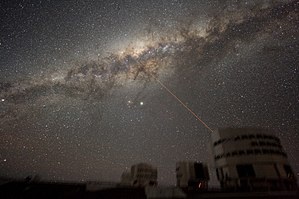|
|
| |
|
|
| |
|
|
|
|
| |
 |
| Image of the night
sky above Paranal, Chile on 21 July 2007, taken
by ESO astronomer Yuri Beletsky. A wide band of
stars and dust clouds, spanning more than 100
degrees on the sky, is seen. This is the Milky
Way, the galaxy to which we belong. |
Milky Way
The Milky Way is our home galaxy. It contains over 200
billion stars, including our Sun.
The Milky Way has a diameter of 100,000 light years, and
is a barred spiral galaxy. The discovery of the Milky
Way goes back to the Ancient Greek philosopher
Democritus. The Milky Way has three main parts: a disk,
in which the Solar System resides, a bulge at the core,
and an all encompassing halo.
This galaxy belongs to the Local Group of three large
galaxies and over 50 smaller galaxies. The Milky Way is
one of the largest galaxies in the group, second to the
Andromeda Galaxy. Milky Way's closest neighbour is Canis
Major Dwarf, which is about 25,000 light years away from
the Earth. The Andromeda Galaxy moves towards the Milky
Way Galaxy, and will meet it in about 3.75 billion
years. Andromeda Galaxy moves with a speed of about
1,800 kilometres per minute. |
|
 |
| The structure of the
Milky Way is thought to be similar to this
galaxy (UGC 12158 imaged by Hubble). |
Size
The stellar disk of the Milky Way Galaxy is
approximately 100,000 light-years (9×1017 km) in
diameter, and is considered to be, on average, about
1000 light years thick.
It is estimated to contain at least 200 billion stars
and possibly up to 400 billion stars. The figure depends
on the number of very low-mass, or dwarf stars, which
are hard to detect, especially more than 300 light years
from our sun. Therefore, present estimates of the total
number are uncertain. This can be compared to the one
trillion (1012) stars of the neighbouring Andromeda
Galaxy.
The stellar disc of the Milky Way does not have a sharp
edge, a radius beyond which there are no stars. Rather,
the number of stars drops smoothly with distance from
the centre of the Galaxy. Beyond a radius of about
40,000 light years, the number of stars drops much
faster, for reasons that are not understood.
Extending beyond the stellar disk is a much thicker disk
of gas. Recent observations indicate that the gaseous
disk of the Milky Way has a thickness of around 12000
light years–twice the previously accepted value. As a
guide to the relative physical scale of the Milky Way,
if the Solar System out to the orbit of Pluto were
reduced to the size of a US quarter (about an inch or 25
mm in diameter), the Milky Way would have a diameter of
2,000 kilometers. At 220 kilometers per second it takes
the Solar System about 240 million years to complete one
orbit of the Galaxy (a galactic year).
The Galactic halo extends outward, but is limited in
size by the orbits of two Milky Way satellites, the
Large and the Small Magellanic Clouds, whose closest
approach is at about 180,000 light years. At this
distance or beyond, the orbits of most halo objects
would be disrupted by the Magellanic Clouds, and the
objects would likely be ejected from the vicinity of the
Milky Way. |
|
 |
| Diagram of the Sun's
location in the Milky Way, the angles represent
longitudes in the galactic coordinate system. |
Galactic center
The galactic disc, which bulges outward at the galactic
center, has a diameter of 70–100,000 light years.
The exact distance from the Sun to the galactic center
is debated. The latest estimates give distances to the
Galactic center of 25–28,000 light years.
Movement of material around the galactic center shows
that it has a compact object of very large mass. The
intense radio source named Sagittarius A*, thought to
mark the center of the Milky Way, is now confirmed to be
a supermassive black hole. Most galaxies are believed to
have a supermassive black hole at their center.
The nature of the galaxy's bar is also actively debated,
with estimates for its half-length and orientation
spanning from 3,300–16,000 light years (short or a long
bar) and 10–50 degrees. Viewed from the Andromeda
Galaxy, it would be the brightest feature of our own
galaxy. |
|
 |
| The Origin of the
Milky Way (c. 1575–1580) by Tintoretto. |
Myth
In Greek mythology, Zeus places his son (the baby
Heracles) whose mother was a mortal woman on Hera's
breast while she is sleeping so that the baby will drink
her divine milk and become immortal. However, Hera wakes
up while she is breastfeeding the baby and realizes she
is nursing a baby she does not know. According to Greek
mythology, she then pushes the baby away and a stream of
her milk sprays the night sky, making a faint band of
light known as the Milky Way. |
|
|
|
|
|
|
|
|
|
|
|
|
|
|
|
|
|
|
Search Fun Easy English |
|
|
|
|
|
|
|
|
|
|
|
|
|
|
|
About
Contact
Copyright
Resources
Site Map |